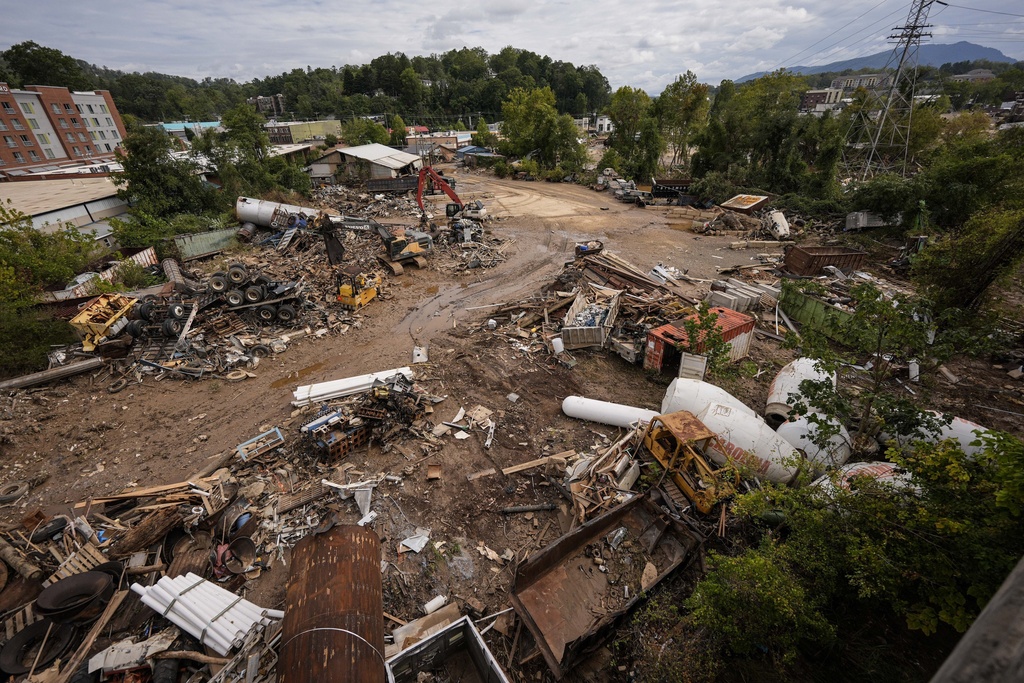NC Residents Struggle After Hurricane Helene’s Devastation \ Newslooks \ Washington DC \ Mary Sidiqi \ Evening Edition \ Hurricane Helene has left western North Carolina in disarray, isolating residents due to washed-out roads and power outages. At least 121 people have died across six states, with Asheville particularly hard hit. Relief efforts are underway, with airlifts, trucks, and even mules bringing essential supplies to affected areas.

Hurricane Helene Aftermath Quick Looks
- Isolation in Asheville: Washed-out roads and lack of power have left Asheville and surrounding areas cut off.
- Death Toll Climbs: At least 121 people have died across six states, with 35 deaths in Asheville’s county.
- Basic Supplies Scarce: Residents have lined up for fresh water, and many lack means to contact loved ones.
- Relief Efforts Mobilized: Government, aid groups, and volunteers are delivering supplies by airlift and mule.
- President Biden’s Pledge: Biden promised federal support for recovery and plans to visit North Carolina soon.
Deep Look
Desperate residents in western North Carolina, isolated by washed-out roads and the absence of power and cellular service, lined up Monday for fresh water and the opportunity to message loved ones that they were safe. It had been days since Hurricane Helene devastated the Southeastern U.S., killing more than 100 people and leaving communities in ruins.
Government officials and aid groups have been racing against time to deliver basic supplies, using airlifts, trucks, and even mules, to Asheville—a major tourist hub—and its neighboring mountain towns. The area has been among the hardest hit by the storm, with widespread flooding and infrastructure failures hampering recovery efforts.
Hurricane Helene’s death toll has reached at least 121 across six states, as officials continue to assess the full extent of the devastation. North Carolina’s Buncombe County, which includes Asheville, reported at least 35 fatalities, while dozens of lives were also lost in Georgia and South Carolina. North Carolina Governor Roy Cooper warned that the toll would likely continue to rise as rescuers reached communities cut off by the destruction.
Many main roads leading into Asheville have been destroyed or blocked by landslides, including sections of Interstate 40. The city’s water system has also been severely damaged, leaving residents scooping creek water into buckets to flush toilets.
How the Worst-Hit Areas Are Coping
In one Asheville neighborhood, a powerful wall of water tore away all the trees and left behind a chaotic, muddy mess. There, neighbors shared whatever resources they had—food, water, and emotional support. “That’s the blessing so far in this,” said Sommerville Johnston, standing outside her home, which had been without power since Friday. She planned to make a venison stew with meat from her powerless freezer before it spoiled, telling neighbors, “Just bring your bowl and spoon.”
Other residents waited in long lines at Mountain Valley Water, a local water distributor, to fill whatever containers they could find, including milk jugs and bottles. Derek Farmer, who arrived with three gallon-sized apple juice containers, explained that despite being prepared for the storm, he felt anxious after three days without clean water. “I just didn’t know how bad it was going to be,” Farmer admitted.
Officials cautioned that rebuilding the widespread damage to homes and infrastructure would be a lengthy and difficult process. Helene has upended life across much of the Southeast, with deaths also reported in Florida and Virginia.
In Lake Lure, a picturesque lake near Asheville, video footage showed masses of debris, including overturned boats and broken docks, covering the water’s surface. The destruction underscored the storm’s power as it roared ashore in northern Florida on Thursday night as a Category 4 hurricane before pushing its way through Georgia, the Carolinas, and Tennessee with torrential rains and intense winds.
The Federal Emergency Management Agency (FEMA) reported Monday that hundreds of roads were still closed across western North Carolina and that more than 1,000 people had taken refuge in emergency shelters. Governor Cooper urged area residents to stay off the roads to keep them clear for emergency responders. More than 50 search and rescue teams were deployed across the region to locate stranded individuals.
Waiting for Help and Searching for a Signal
Several dozen people gathered on high ground in Asheville on Monday, drawn by one of the few functioning cell signals in the area. Some managed to text loved ones a simple message: “I’m OK.” For many, the days have blurred together. “Is this day three or day four?” wondered Colleen Burnet, reflecting on the chaos. “It’s all been a blur.”
The storm brought the worst flooding in North Carolina in a century. Rainfall in some areas exceeded 2 feet (61 centimeters) since Wednesday, swamping entire neighborhoods.
President Joe Biden promised federal assistance for survivors, committing to support the southeastern U.S. “as long as it takes” for recovery. Biden said he planned to request additional funds from Congress for disaster aid and intends to visit North Carolina later in the week, once the immediate need for search and rescue operations has subsided.
FEMA Administrator Deanne Criswell joined Governor Cooper to survey the damage, while relief trucks and cargo planes began delivering food and water to affected communities. Ten federal search and rescue teams were on the ground, with another nine on their way.
Volunteers have also stepped in to help. Mike Toberer, who owns a dozen mules, decided to use them to carry supplies—including food, water, and diapers—to hard-to-reach mountainous areas. “We’ll take our chainsaws, and we’ll push those mules through,” Toberer said, adding that each mule could carry up to 200 pounds (90 kilograms) and travel at 2 mph (3.2 kph).
Why Western North Carolina Was Hit So Hard
Western North Carolina endured severe devastation partly because the remnants of Hurricane Helene encountered the cooler air and high elevations of the Appalachian Mountains, causing prolonged heavy rainfall. Asheville and its neighboring mountain towns are mostly built in valleys, making them particularly vulnerable to flooding. Moreover, the ground was already saturated from previous rains before Helene arrived, compounding the flood risk, explained Christiaan Patterson, a meteorologist with the National Weather Service. “By the time Helene came into the Carolinas, we already had that rain on top of more rain,” Patterson said.
Experts have pointed to climate change as a contributing factor in the growing intensity of hurricanes like Helene. Warmer ocean waters are fueling rapid intensification, turning tropical storms into powerful hurricanes within a matter of hours.
Destruction Across the Southeast
The destruction caused by Hurricane Helene stretched far beyond North Carolina. Along Florida’s Gulf Coast, floodwaters inundated the Clearwater Marine Aquarium, forcing workers to move manatees and sea turtles to safety. Although the animals were unharmed, much of the aquarium’s essential equipment was damaged or destroyed, according to James Powell, the aquarium’s executive director.
In Georgia, Governor Brian Kemp said that Helene “literally spared no one.” In and around Augusta, a city of approximately 200,000 people near the South Carolina border, power remained out for most residents as of Monday. Kemp and other officials made efforts to reassure locals that they understood their suffering and were working towards restoring essential services.
South Carolina, which reported at least 25 fatalities, experienced its deadliest tropical cyclone since Hurricane Hugo struck the state in 1989, killing 35 people.
Tropical Storm Kirk Forms in Atlantic
In other weather news, Tropical Storm Kirk formed on Monday in the eastern Atlantic Ocean. According to the U.S. National Hurricane Center, Kirk is expected to become a “large and powerful hurricane” by Tuesday night or Wednesday. The storm was located about 700 miles (1,125 kilometers) west of the Cabo Verde Islands, with maximum sustained winds of 45 mph (70 kph). There were no coastal watches or warnings issued, as Kirk was not expected to impact land.
NC Residents NC Residents NC Residents NC Residents







